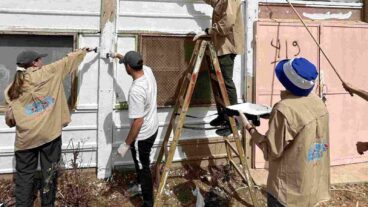Like all natural disasters, earthquakes know no boundaries and that’s the reason one Israeli seismologist, Dr. Hillel Wust-Bloch has masterminded a new earthquake mapping research partnership between Jordanian, Palestinian and Israeli scientists.
Wust-Bloch, from the Department of Geophysics and Planetary Sciences at Tel Aviv University, believes this is the first time that Earth scientists from these three regions have worked together directly. In the past cooperation only took place with the help of a third party like the United Nations.
The Middle East is prone to earthquakes and one of the most significant fault lines is the Dead Sea Fault, which runs along the Jordan Valley from Eilat to Beit She’an, straight through the ancient city of Jericho – an area of great significance for Palestinians, Jordanians and Israelis alike.
This region has been hit by major earthquakes throughout the past 2,000 years, and experts predict that another devastating earthquake is imminent and the damage will be widespread. Many fear such a disaster could add to the volatile situation in the Middle East.
Wust-Bloch hopes the new four-year project, which includes partners from Al-Balqa University in Jordan, and An Najah University in Nablus, could mitigate these risks and improve the region’s stability.
Scientists from the three universities will simultaneously deploy six seismic microscopes, developed by Wust-Bloch and a German colleague, in the Jericho region, in order to map a 100-square-kilometer area. The seismic microscopes, which use nano-scale seismic monitoring techniques and have been employed in the past to help scientists predict where sink holes around the Dead Sea may occur, detect tiny failures inside the earth’s crust.
“From a scientific point of view, this project is innovative because we are monitoring the seismic activity of a region which is well-known, but we are doing it at much lower thresholds,” says Swiss-born Wust-Bloch, who has worked in the past with Jordanian scientists on problems related to the Dead Sea, which is shared by both countries.
There is no way to predict where and when an earthquake will occur exactly, or what its magnitude might be. But scientists can listen to the earth for small clues, says Wust-Bloch.
The team will meet several times a year to discuss their findings and assess potential hazards in the region, says Wust-Bloch. He believes that such an earthquake map will be useful for attracting industry and high-tech projects in the Palestinian and Jordanian regions.
“Companies like Intel won’t invest a single dollar in the Jericho region unless the seismic hazard is properly assessed,” he explains.
Wust-Bloch also plans for the research to extend into the educational realm. He hopes that the material collected by the researchers will be presented, in appropriate cultural contexts, to teach people in the region about seismic hazards and what to do when a major earthquake strikes.
Wust-Bloch believes that earthquake research between Palestinians, Jordanians, and Israelis will break down age-old cultural rifts and open the whole region. A prosperous future for the Palestinians and Jordanians means a better future for Israelis, too, he says.
Local experts will be trained on how to conduct earthquake research in the Palestinian Authority and in Jordan. This will prevent “brain drain,” since scientists from these regions tend to emigrate to Europe, North America, or the Gulf region for work.
“Young Jordanian and Palestinian scientists simply cannot find adequate work in the region,” concludes Wust-Bloch. “Currently, once they are overseas and get their degree, there are too few opportunities for them to come back to.”
It is a shame, adds Wust-Bloch, not to take advantage of an existing pool of bright young scientists familiar with both foreign and local worldviews, who could fulfill the scientific needs of the region as well as helping to bridge cultural differences.![]()












